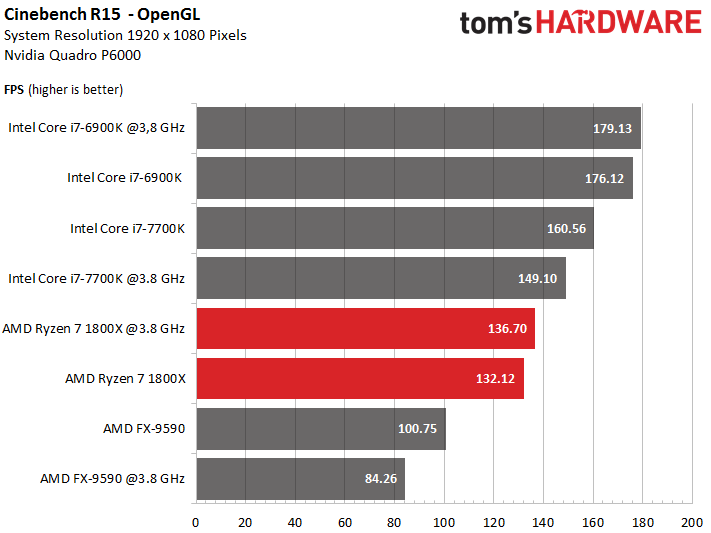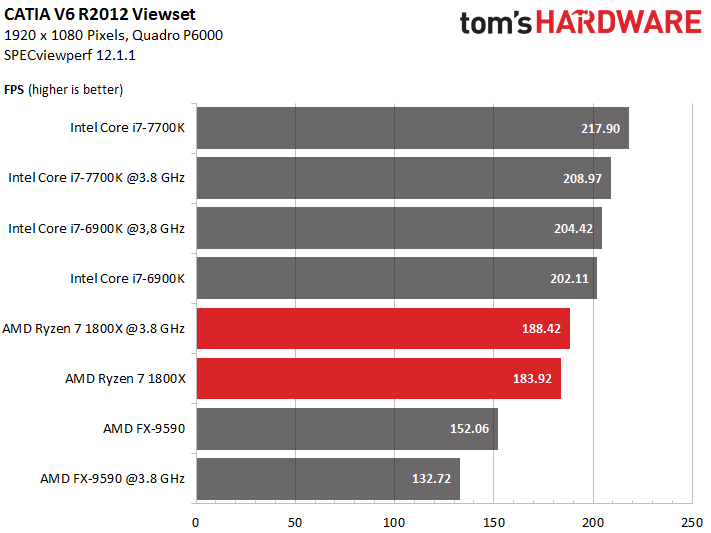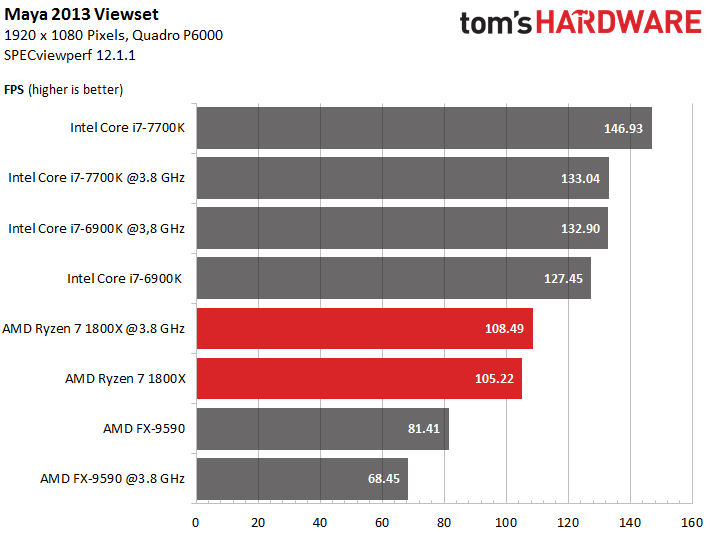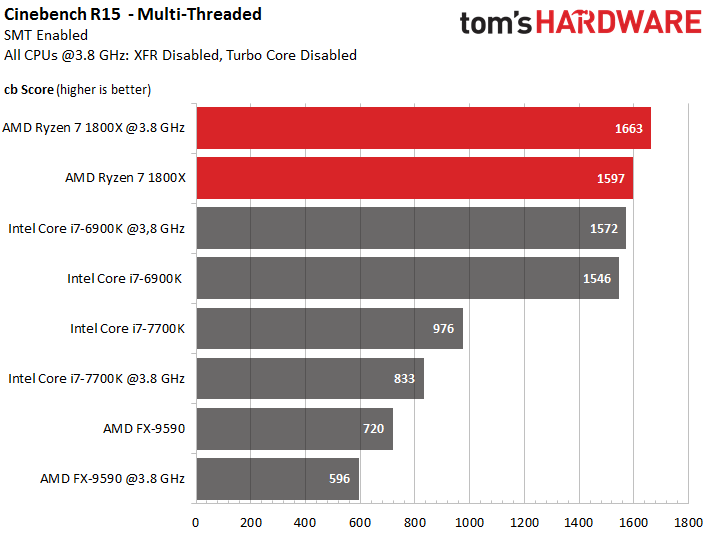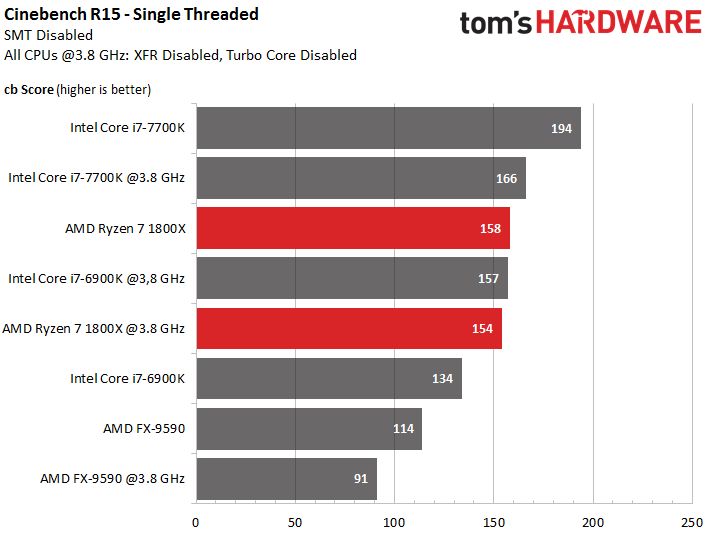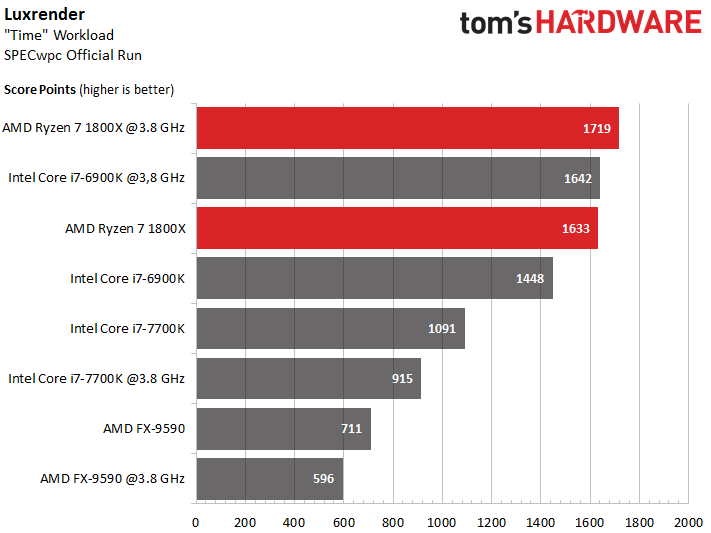AMD Ryzen 7 1800X CPU Review
Why you can trust Tom's Hardware
Results: Workstation
Let's take a look at several common workstation productivity applications.
The AutoCAD results remind us of what we reported on the previous page when we looked at output devices. AMD’s Ryzen 7 1800X ends up exactly where you’d think, based on those findings. There’s no real parallelization, but there’s plenty of system memory and cache usage, which turns out to be a combination that puts its performance squarely in the middling category.
Ryzen’s 3D performance is okay, especially in light of the number of cores not being the priority here. Consequently, the results aren’t surprising.
The Cinebench R15 OpenGL benchmark gives us a preview of what we’re in for if an application has not been optimized for Ryzen. It brings up the rear in spite of noticeable multithreading. Then again, it’s also often more than 30% faster than its predecessor, which is running at 5GHz.
Important NoteMany of the professional applications in the development field have been optimized and compiled for Intel CPUs. This is reflected in the performance numbers. Still, we want to provide a complete performance picture, so we won’t skip them. The results might motivate the application developers to focus more of their efforts on AMD’s Ryzen and Naples so that their users have two options.
One of these professional applications is Solidworks by Dassault Systemès. It’s clear to see across the two composites’ performance numbers that both single- and multithreaded scenarios are affected to varying degrees, in spite of the rendering results having an influence on the overall results as well.




The same general principle applies to Creo 3.0 by PTC. Just like Solidworks, this application’s an important and de-facto standard tool for professional development.
Get Tom's Hardware's best news and in-depth reviews, straight to your inbox.
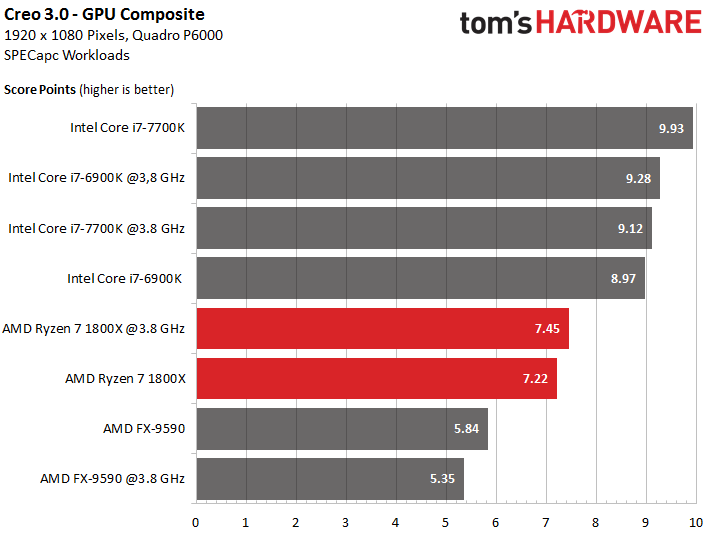
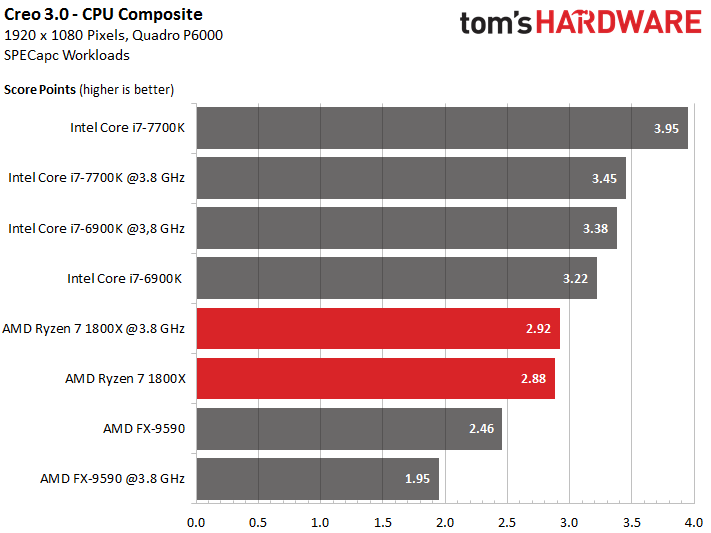


Catia’s older, and it’s not optimized for multithreaded performance. This means that the CPUs are left with using just one single core, which results in a lack of performance for AMD’s newest offering.
Autodesk’s Maya 2013 has the same problem, since graphics output in real time isn’t among the tasks that lend themselves well to parallelization.
Parallelization vs. Single-Core Performance
We start with AMD’s very own favorite example that the company kept showing during the presentations: Cinebench R15. First, we need to note that the only way to get the following numbers is by disabling the AVX instruction set completely. This is to say that Cinebench might be a good example, but it can’t necessarily stand in for all that many other applications when it comes to the AMD Ryzen 7 1800X’s real-world performance. Nevertheless, these results provide us with a good basis of comparison for what’s to come later. Note: For all 3.8 GHz benchmarks we turned XFR off (AMD) and Turbo Core off (Intel). For the single core benchmark we also disabled SMT.
Using just one core at stock clocks, AMD’s Ryzen 7 1800X leads Intel’s Core i7-6900K. Looking at them at the same clock frequency, which we set at 3.8GHz for all tests, provides the best comparison, and here Ryzen 7 1800X @3.8 GHz is a tick slower than the Core i7-6900K @3.8 GHz.
Rendering
Next up, we have two different Blender benchmarks. First, all we do is generate a picture output with a sample size of 200 pixels. AMD’s Ryzen 7 1800X beats Intel’s Core i7-6900K at the same clock frequency, but falls behind at stock clock frequencies.
Then again, this type of rendering is just the final step in a daily workload, so we run the preceding steps in addition to the final rendering for our second benchmark. This includes preview pictures and content creation-related processes.
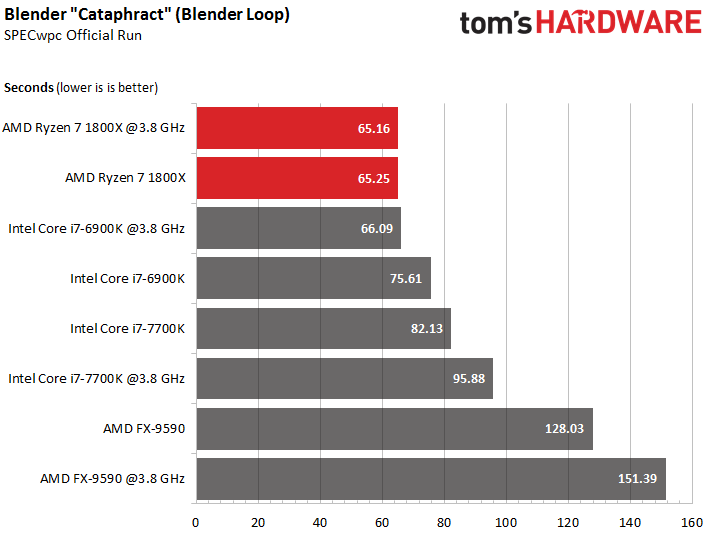
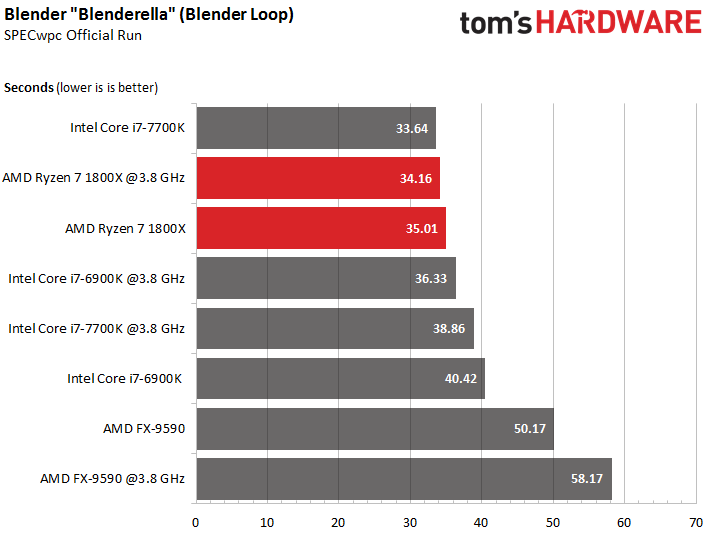

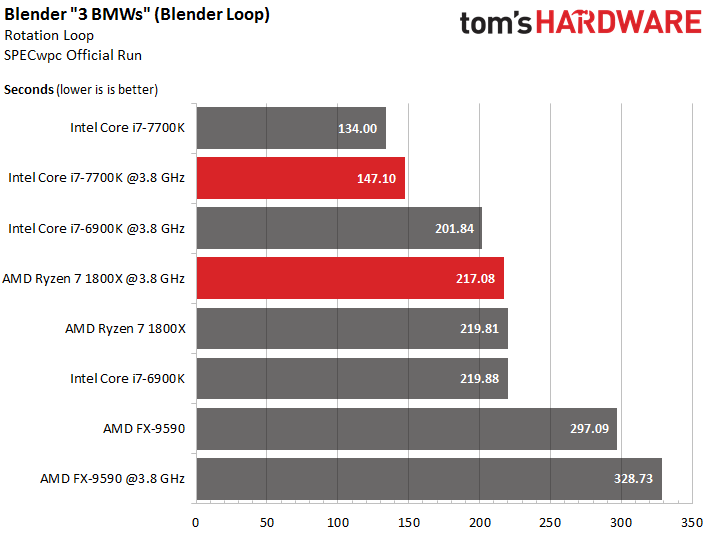






AMD’s Ryzen is unbeatable at pure rendering tasks, and it does a solid job otherwise.
It’s a neck-and-neck race between AMD’s Ryzen 7 1800X and Intel’s Core i7-6900K once again. At the same clock frequency, Ryzen pulls ahead when using the console version, which doesn’t include any workflow-related tasks, but just the graphics output.
As was the case with Blender, the 3ds Max benchmark distinguishes between several different areas, which don’t just include CPU rendering and, consequently, provide a good idea of what the work processes would feel like to the user. AMD’s Ryzen 7 is at a disadvantage when there’s real-time graphics output via the GPU or when only a few cores are used.


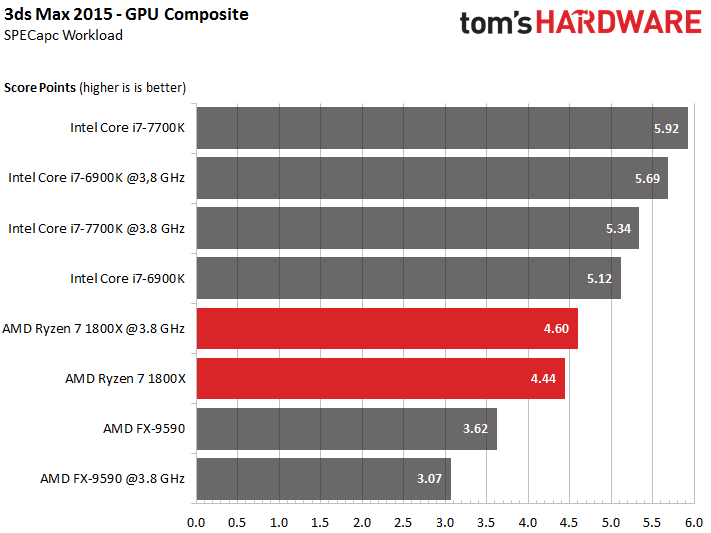







Bottom Line
There might have been a few hiccups here and there, which were usually due to the specific software, but, overall, AMD’s Ryzen 7 1800X seems surprisingly mature and offers solid performance. It’s questionable if it’s a good investment if the application in question has been heavily optimized for Intel processors, but there’s no real drawback to its use as a general-purpose CPU.
Current page: Results: Workstation
Prev Page Results: Desktop & Office Next Page Results: Scientific & Engineering Computations And HPC
Paul Alcorn is the Editor-in-Chief for Tom's Hardware US. He also writes news and reviews on CPUs, storage, and enterprise hardware.
-
vrumor Well, at the very least, it is competition. Competition drives innovation and lower costs. Well done AMD.Reply -
kiniku Why did I feel AMD was hiding something? Understandably the "gamer market" is comparatively small. But couldn't AMD have designed a CPU that worked well in gaming/desktops and in data centers? Disappointing.Reply
(But I have a 5820K. The best Ryzen in the world would not have had me switch anyway.) -
xryanx123 Bias review as always. Most of your information is obviously screwed up. How do you get 4.0ghz at 1.45v. When that's not even an overclock for the chip (not really at least compared to stock) yet you're already pushing 1.45v? You're tailoring your articles for the uneducated. Duck off tomsReply -
captaincharisma in the end the best anyone can hope from AMD is that it spooked intel enough to lower its pricesReply -
ssdpro In a hurry to compare various site's gaming results, it appears differing sites are finding the same thing: gaming performance is acceptable but below 4c/8t Intel offerings. If you spend your day encoding or multi-thread benching this is a monster bargain.Reply
With the good and bad, I think we can all agree the good here is competition. There is some now. -
Pompompaihn All along AMD was claiming to equal/beat Broadwell-E in comparative tasks at half the price, and from another review that included Broadwell-E, it's done that. I don't recall ANY AMD press saying it was going to beat the 7700K in straight up gaming. So, target set, and hit. That's a win in my book. But now, need to see what they can do with the smaller core count chips and if they can scale frequency to be competitive in the gaming sector.Reply -
Dionisiatis Maybe i missed it but i would love to see a perf/dollar ratio comparison. Im sure Ryzen would occupy the top position, and it would also make it clear that AMD achieved extraordinary results in bringing such high performance to the average consumer that cant 700+ dollars for a CPU.Reply -
jackspeed @Dionisiatis the 7700K is cheaper then the 1800X so for gamers it currently is the best CPU. now games have yet to optimize for the new AMD architecture, so maybe soon it will be a different story.Reply -
Aspiring techie Your "Heating up AMD Ryzen" video on the Power and Temperatures tab is still private. I can't watch it.Reply -
Fails in gaming, and for multitasking stuff i got Xeon 14/28 who is doing all that encoding and other stuff for $300 on eBay.Reply
In my opinion AMD failed and they really pulled BS by fooling people into pre ordering but it turns out that in gaming sucks..


